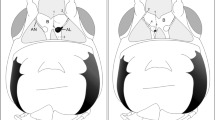Summary
The basic organization of sensory projections in the suboesophageal central nervous system of a spider (Cupiennius salei Keys.) was analyzed with anterograde cobalt fills and a modified Golgi rapid method. The projections of three lyriform slit sense organs and of tactile hairs located proximally on the legs are described and related to central nerve tracts. There are five main longitudinal sensory tracts in the central region of the suboesophageal nervous mass arranged one above the other. Whereas the three dorsal ones contain fibers from the lyriform organs, the two ventral ones contain axons from the hair receptors. Axons from all three lyriform organs have typical shapes and widely arborizing ipsilateral intersegmental branches and a few contralateral ones. The terminal branches of the afferent projections from identical lyriform organs on each leg form characteristic longitudinal pathways, typical of each organ: U-shaped, O-shaped, or two parallel bundles. The terminations of the hair sensilla are ipsilateral and intersegmental. Two large bilaterally arranged “longitudinal sensory association tracts” receive inputs from all legs including the dense arborizations from tactile hairs, lyriform organs, and other sense organs. These tracts may serve as important integrating neuropils of the suboesophageal central nervous system.
Similar content being viewed by others
References
Anton S, Barth FG (1989) Central projections of spider trichobothria. In: Elsner N, Singer W (eds) Dynamics and plasticity in neuronal systems (Proc 17 Göttingen Neurobiol Conf), Thieme, Stuttgart
Babu KS (1969) Certain histological and anatomical features of the central nervous system of a large Indian spider, Poecilotheria. Am Zool 9:113–119
Babu KS, Barth FG (1984) Neuroanatomy of the central nervous system of the wandering spider, Cupiennius salei Keys. Zoomorphology 104:344–359
Babu KS, Barth FG, Strausfeld NJ (1985) Intersegmental sensory tracts and contralateral motor neurons in the leg ganglia of the spider Cupiennius salei Keys. Cell Tissue Res 241:53–57
Bacon JP, Altman JS (1977) A silver intensification method for cobalt-filled neurones in whole-mount preparations. Brain Res 138:359–363
Barth FG (1971) Der sensorische Apparat der Spaltsinnesorgane (Cupiennius salei Keys., Araneae). Z Zellforsch 112:212–246
Barth FG (1976) Sensory information from strains in the exoskeleton. In: Hepburn HR (ed) The insect integument. Elsevier, Amsterdam Oxford New York, 445–473
Barth FG (1985) Slit sensilla and the measurement of cuticular strains. In: Barth FG (ed) Neurobiology of arachnids. Springer, Berlin Heidelberg New York Tokyo, pp 162–188
Barth FG, Libera W (1970) Ein Atlas der Spaltsinnesorgane von Cupiennius salei Keys. Chelicerata (Araneae). Z Morphol Tiere 68:343–369
Barth FG, Stagl J (1976) The slit sense organs of arachnids. A comparative study of their topography on the walking legs. Zoomorphology 86:1–23
Barth FG, Ficker E, Federle H-U (1984) Model studies on the mechanical significance of grouping in compound spider slit sensilla. Zoomorphology 104:216–222
Brüssel A, Gnatzy W (1985) A somatotopic organization of leg afferents in the spider Cupiennius salei Keys. (Araneae, Ctenidae). Experientia 41:468–470
Bullock ThH, Horridge GA (1965) Structure and function in the nervous systems of invertebrates. WH Freeman, San Francisco London
Eckweiler W (1987) Tasthaare, Beinmuskelreflexe und Einstellung der Körperhöhe bei Jagdspinnen. Dissertation, J.W. Goethe-Universität, Frankfurt am Main
Eckweiler W, Seytarth E-A (1988) Tactile hairs and the adjustment of body height in wandering spiders; behavior, leg reflexes, and afferent projections in the leg ganglia. J Comp Physiol [A] 162:611–621
Eckweiler W, Hammer K, Seyfarth E-A (1988) Lange “glatte” Haare auf der Spinnencoxa: Sinnesphysiologie, zentrale Projektionen und proprioceptive Funktion. Verh Dtsch Zool Ges 81:290–291
Foelix RF (1985) Mechano- and chemoreceptive sensilla. In: Barth FG (ed) Neurobiology of arachnids. Springer, Berlin Heidelberg New York Tokyo, pp 118–137
Görner P (1965) A proposed transducing mechanism for a multiply innervated mechanoreceptor (trichobothrium) in spiders. Cold Spring Harbor Symp Quant Biol 30:69–73
Gregory GE (1980) The protargol technique. In: Strausfeld NJ, Miller TA (eds) Neuroanatomical techniques. Insect nervous system. Springer, New York, pp 77–97
Gronenberg W (1987) Neuronal elements in the CNS of a spider (Cupiennius salei): anatomy and physiology. In: Elsner N, Creutzfeldt O (eds) New frontiers in brain research (Proc 15 Göttingen Neurobiol Conf) Thieme, Stuttgart, pp 78
Hanström B (1919) Zur Kenntnis des zentralen Nervensystems der Arachnoiden und Pantopoden. Inaug Dissertation, Lund Aktienbologet Skanska
Hanström B (1928) Vergleichende Anatomie des Nervensystems der wirbellosen Tiere. Springer, Berlin Heidelberg New York Tokyo, pp 392–407
Hergenröder R, Barth FG (1983) Vibratory signals and spider behavior: How do the sensory inputs from the eight legs interact in orientation? J Comp Physiol [A] 152:361–371
Milde JJ, Seyfarth E-A (1988) Tactile hairs and leg reflexes in wandering spiders: physiological and anatomical correlates of reflex activity in the leg ganglia. J Comp Physiol [A] 162:623–651
Palmgren A (1948) A rapid method for selective silver staining of nerve fibres and nerve endings in mounted paraffin sections. Acta Zool 29:377–392
Seyfarth E-A, Hammer K (1988) Cuticular sense organs on the proximal spider leg: specificity and somatotopy of their central projections. In: Elsner N, Barth FG (eds) Sense organs (Proc 16 Göttingen Neurobiol Conf), Thieme, Stuttgart, pp 83
Seyfarth E-A, Pflüger JH (1984) Proprioceptor distribution and control of a muscle reflex in the tibia of spider legs. J Neurobiol 15:365–374
Seyfarth E-A, Eckweiler W, Hammer K (1985) Proprioceptors and sensory nerves in the legs of a spider, Cupiennius salei (Arachnida, Araneida). Zoomorphology 105:190–196
Speck-Hergenröder J, Barth FG (1987) Tuning of vibration sensitive neurons in the central nervous system of a wandering spider, Cupiennius salei Keys. J Comp Physiol [A] 160:467–475
Strausfeld NJ (1980) The Golgi method: its application to the insect nervous system and the phenomenon of stochastic impregnation. In: Strausfeld NJ, Miller TA (eds) Neuroanatomical techniques. Insect nervous system. Springer, Berlin Heidelberg New York Tokyo, pp 132–190
Tyrer NM, Altman JS (1974) Motor and sensory flight neurones in a locust demonstrated using cobalt chloride. J Comp Neurol 157:117–138
Author information
Authors and Affiliations
Rights and permissions
About this article
Cite this article
Babu, K.S., Barth, F.G. Central nervous projections of mechanoreceptors in the spider Cupiennius salei Keys.. Cell Tissue Res. 258, 69–82 (1989). https://doi.org/10.1007/BF00223146
Accepted:
Issue Date:
DOI: https://doi.org/10.1007/BF00223146




